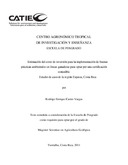Mostrar el registro sencillo del ítem
Estimación del costo de inversión para la implementación de buenas prácticas ambientales en fincas ganaderas para optar por una certificación sostenible: estudio de caso de la región Esparza, Costa Rica
| dc.contributor.author | Castro Vargas, Rodrigo E. | |
| dc.date.accessioned | 2014-10-20T04:53:05Z | |
| dc.date.available | 2014-10-20T04:53:05Z | |
| dc.date.issued | 2011 | es_ES |
| dc.identifier | 375670 | es_ES |
| dc.identifier.uri | https://repositorio.catie.ac.cr/handle/11554/4970 | |
| dc.description | Tesis (Mag. Sc.) -- CATIE, Turrialba (Costa Rica), 2011 | es_ES |
| dc.description.abstract | El presente estudio se realizó para evaluar la aplicabilidad de la norma de certificación de Ganadería sostenible de Rainforest Alliance (RA) mediante la evaluación del grado de cumplimiento de nueve indicadores de la norma en fincas ganaderas en el Cantón de Esparza, Provincia de Puntarenas, Costa Rica. La mayor necesidad dentro del cumplimiento de los criterios es la protección de las fuentes de agua ya que ninguna finca ha cumplido con estos criterios. Con base en el análisis económico y debido a las diferencias en los niveles productivos, no se pudo determinar un precio mínimo de venta de los productos carne, queso y leche, además se evidenció que aquellas fincas con un cumplimiento del 59 y 66% no requieren de incentivos externos para poder hacer frente a los costos de implementación de nuevas tecnologías. El sistema de PSA podría ser una alternativa para mitigar el costo de implementación de éstas dentro de las fincas para poder cumplir con el 90% del total requerido para optar por la certificación de Ganadería sostenible o mediante un crédito blando o con bajas tasas de interés puede ser factible para suplir el capital en el establecimiento de las tecnologías, pero aun así las finca con bajo cumplimiento les sería difícil poder optar por la certificación. This work comes as a proposed certification standard for sustainable livestock Rainforest Alliance (RA) to provide new alternatives to livestock producers to innovate and produce preserving the environment, 35 farMON were selected randomly using the database of land uses generated by the GEF / Silvopastoril Esparza for the region, where pastures were sampled 334 (242 ha) which were mostly found in timber (Oak, Laurel, Guanacaste, Guachipelín, Guayaquil) and species that fruit or foliage (Guácimo, guava, coyol, among others). The greatest need in the fulfillment of the criteria lies in the protection of water sources and that no farm has met these criteria. Based on the economic analysis due to differences in production levels, could not determine a minimum price for sale of meat products, cheese and milk also became clear that those farMON with a compliance of 59 and 66% did not require external incentives to meet the costs of implementing new technologies. The system of payment for environmental services could be an alternative to mitigate the cost of implementing them within farMON to meet 90% of the total required to qualify for certification of sustainable livestock or by a soft loan or low rates of interest may be feasible to supply the capital in the development of technologies, yet the farm with low compliance would be difficult to qualify for certification. | es_ES |
| dc.language.iso | es | es_ES |
| dc.publisher | CATIE, Turrialba (Costa Rica) | es_ES |
| dc.subject | GANADERIA | |
| dc.subject | DESARROLLO SOSTENIBLE | |
| dc.subject | CERTIFICACION | |
| dc.subject | INDICADORES | |
| dc.subject | COSTA RICA | |
| dc.subject | PROTECCION AMBIENTAL | |
| dc.subject | CONTROL DE CALIDAD | |
| dc.subject | BIENESTAR ANIMAL | |
| dc.title | Estimación del costo de inversión para la implementación de buenas prácticas ambientales en fincas ganaderas para optar por una certificación sostenible: estudio de caso de la región Esparza, Costa Rica | es_ES |
| dc.title.alternative | Estimated investment cost for the implementation of good practices in livestock farms to choose a sustainable certification: case study of the region Esparza, Costa Rica | es_ES |
| dc.type | Tesis de maestría | es_ES |
| dcterms.rights | acceso abierto | es_Es |
Ficheros en el ítem
Este ítem aparece en la(s) siguiente(s) colección(ones)
-
Tesis [2889]


